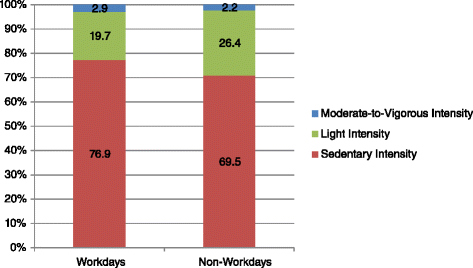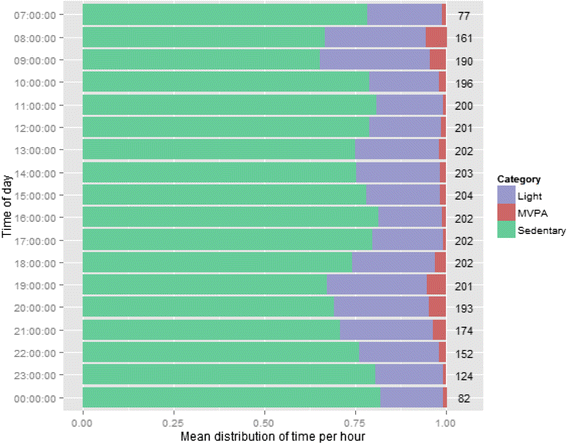Assessing and understanding sedentary behaviour in office-based working adults: a mixed-method approach
- PMID: 27117178
- PMCID: PMC4847225
- DOI: 10.1186/s12889-016-3023-z
Assessing and understanding sedentary behaviour in office-based working adults: a mixed-method approach
Abstract
Background: Sedentary behaviours (SB) can be characterized by low energy expenditure in a reclining position (e.g., sitting) often associated with work and transport. Prolonged SB is associated with increased risk for chronic conditions, and due to technological advances, the working population is in office settings with high occupational exposure to SB. This study aims to assess SB among office workers, as well as barriers and strategies towards reducing SB in the work setting.
Methods: Using a mixed-methods approach guided by the socio-ecological framework, non-academic office workers from a professional school in a large public university were recruited. Of 180 eligible office workers, 40 enrolled and completed all assessments. Self-reported and objectively measured SB and activity levels were captured. Focus group discussion (FGD) were conducted to further understand perceptions, barriers, and strategies to reducing workplace SB. Environmental factors were systematically evaluated by trained research staff using an adapted version of the Checklist for Health Promotion Environments at Worksites (CHEW). Thematic analysis of FGD was conducted and descriptive analysis of quantitative data was performed.
Results: The sample was mostly Chinese (n = 33, 80 %) with a total of 24 (60 %) female participants. Most participants worked five days a week for about 9.5(0.5) hrs/day. Accelerometer data show that participants spend the majority of their days in sedentary activities both on workdays (76.9 %) and non-workdays (69.5 %). Self-report data confirm these findings with median sitting time of 420(180) minutes at work. From qualitative analyses, major barriers to reducing SB emerged, including the following themes: workplace social and cultural norms, personal factors, job scope, and physical building/office infrastructure. CHEW results confirm a lack of support from the physical infrastructure and information environment to reducing SB.
Conclusions: There is high SB among office workers in this sample. We identified multiple levels of influence for prolonged occupational SB, with a particular emphasis on workplace norms and infrastructure as important barriers to reducing SB and increasing PA. A larger, representative sample of the Singaporean population is needed to confirm our findings but it seems that any intervention aimed at reducing SB in the workplace should target individual, environmental, and organizational levels.
Keywords: Adult; Occupational Health; Sedentary lifestyle; Workplace.
Figures
Similar articles
-
Understanding and Influencing Occupational Sedentary Behavior: A Mixed-Methods Approach in a Multiethnic Asian Population.Health Educ Behav. 2020 Jun;47(3):419-429. doi: 10.1177/1090198119885431. Epub 2019 Oct 29. Health Educ Behav. 2020. PMID: 31661980
-
Perceptions of the acceptability and feasibility of reducing occupational sitting: review and thematic synthesis.Int J Behav Nutr Phys Act. 2018 Sep 18;15(1):90. doi: 10.1186/s12966-018-0718-9. Int J Behav Nutr Phys Act. 2018. PMID: 30227861 Free PMC article. Review.
-
Feasibility and acceptability of reducing workplace sitting time: a qualitative study with Australian office workers.BMC Public Health. 2016 Sep 5;16(1):933. doi: 10.1186/s12889-016-3611-y. BMC Public Health. 2016. PMID: 27595754 Free PMC article.
-
Sitting time and step counts in office workers.Occup Med (Lond). 2014 Apr;64(3):188-92. doi: 10.1093/occmed/kqt164. Epub 2014 Jan 29. Occup Med (Lond). 2014. PMID: 24477502
-
Sedentary behaviors and physical activity of the working population measured by accelerometry: a systematic review and meta-analysis.BMC Public Health. 2024 Aug 6;24(1):2123. doi: 10.1186/s12889-024-19449-y. BMC Public Health. 2024. PMID: 39107699 Free PMC article.
Cited by
-
Changes in Workers' Sedentary and Physical Activity Behaviors in Response to the COVID-19 Pandemic and Their Relationships With Fatigue: Longitudinal Online Study.JMIR Public Health Surveill. 2021 Mar 26;7(3):e26293. doi: 10.2196/26293. JMIR Public Health Surveill. 2021. PMID: 33727211 Free PMC article.
-
Workplace Physical Activity Barriers and Facilitators: A Qualitative Study Based on Employees Physical Activity Levels.Int J Environ Res Public Health. 2022 Aug 1;19(15):9442. doi: 10.3390/ijerph19159442. Int J Environ Res Public Health. 2022. PMID: 35954798 Free PMC article.
-
Iterative four-phase development of a theory-based digital behaviour change intervention to reduce occupational sedentary behaviour.Digit Health. 2020 Mar 25;6:2055207620913410. doi: 10.1177/2055207620913410. eCollection 2020 Jan-Dec. Digit Health. 2020. PMID: 32257366 Free PMC article.
-
Factors Affecting Physical Activity Adherence in Male Office Workers Based on Self-Determination Theory: The Mediating Effects of Psychological Need Satisfaction and Autonomous Motivation.Healthcare (Basel). 2025 Jul 30;13(15):1852. doi: 10.3390/healthcare13151852. Healthcare (Basel). 2025. PMID: 40805885 Free PMC article.
-
Social-ecological correlates of accelerometer-measured occupational sitting among Japanese desk-based workers.BMC Public Health. 2019 Nov 8;19(1):1489. doi: 10.1186/s12889-019-7782-1. BMC Public Health. 2019. PMID: 31703665 Free PMC article.
References
MeSH terms
LinkOut - more resources
Full Text Sources
Other Literature Sources
Medical




